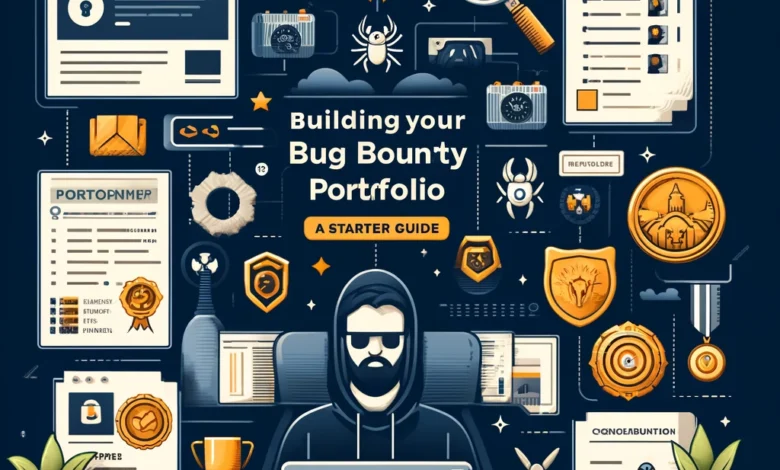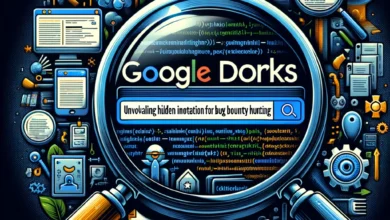Building Your Bug Bounty Hunter Portfolio: A Starter Guide
Crafting the Perfect Showcase of Your Cybersecurity Skills

Introduction: Unveiling the Power of Your Bug Bounty Hunter Portfolio
In the dynamic and densely populated world of cybersecurity, distinguishing yourself isn’t just about honing your skills—it’s about how you showcase them. Enter the bug bounty hunter portfolio, a strategic compilation of accomplishments, discoveries, and contributions that serves as more than just a resume; it’s a narrative of your journey, expertise, and potential. A well-crafted portfolio is indispensable for aspiring bug bounty hunters eager to carve out a space for themselves in this competitive domain.
The significance of a portfolio extends beyond a mere list of achievements. It’s a multifaceted tool for personal branding, a beacon that highlights your technical prowess and tells your unique story. In a field where staying ahead means continuous learning and adaptability, your portfolio becomes a living document, evolving with each new vulnerability uncovered, each project contributed to, and every milestone achieved.
Moreover, a thoughtfully presented portfolio opens up avenues for networking and career advancement. It speaks to your dedication and passion, resonating with prospective collaborators, employers, and the wider cybersecurity community. Whether you’re engaging with fellow hunters, participating in forums, or applying for roles that demand a proven track record, your portfolio stands as a testament to your capabilities and ambitions.
But what transforms a collection of achievements into a compelling portfolio? How do you ensure that your portfolio not only captures attention but also effectively communicates your skills, experiences, and potential? As members of the BugBustersUnited community, you’re about to embark on a journey to explore these questions, crafting a portfolio that not only showcases your technical acumen but also paves the way for meaningful connections and opportunities in the vast cybersecurity landscape.
Your portfolio is more than a showcase; it’s your professional fingerprint in the digital world. Let’s dive into how you can build a portfolio that truly reflects your journey, your growth, and your aspirations as a bug bounty hunter.
Biography: Crafting Your Cybersecurity Persona
The biography section of your bug bounty hunter portfolio is not just an introduction—it’s your first opportunity to make a lasting impression. This is where you lay the groundwork, sharing your story in a way that resonates with readers and paints a vivid picture of your path to becoming a cybersecurity enthusiast. Here’s how you can craft a compelling biography that encapsulates your background, motivations, and the unique perspectives you bring to the field.
Start with Your Background
Begin by providing an overview of your journey into cybersecurity. This doesn’t have to be a detailed chronological account but should highlight key moments or decisions that led you to pursue bug bounty hunting. Perhaps you were fascinated by computers from a young age, or maybe a particular incident sparked your interest in digital security.
Example: “With a curious mind and a penchant for puzzles, my journey into cybersecurity began in my teenage years, hacking together code on an old desktop in my basement. The thrill of solving complex problems and understanding the mechanics behind digital systems fueled my passion, leading me to pursue a degree in computer science.”
Highlight What Drives You
What motivates you as a bug bounty hunter? Is it the challenge of uncovering vulnerabilities that others overlook, the continuous learning, or the satisfaction of enhancing digital security? Identifying and articulating your motivations gives readers insight into what fuels your pursuit of cybersecurity excellence.
Example: “What drives me is not just the thrill of the hunt but the profound impact of ensuring digital safety. In a world increasingly reliant on digital infrastructures, the role of a bug bounty hunter in safeguarding information feels not just important but essential.”
Share Your Unique Perspectives or Experiences
Every bug bounty hunter brings a unique set of perspectives and experiences to the table. Maybe you have a background in an unrelated field that provides you with a different approach to problem-solving, or perhaps you’ve overcome significant challenges on your path to where you are today. Sharing these aspects of your story can differentiate you from others and add depth to your professional persona.
Example: “Transitioning from a career in graphic design to cybersecurity, I bring an unconventional perspective to bug bounty hunting. My design background has honed my attention to detail and pattern recognition, skills that prove invaluable in identifying subtle vulnerabilities and thinking outside the conventional cybersecurity box.”
Conclude with Your Current Focus and Aspirations
Wrap up your biography by briefly mentioning what you’re currently focusing on in your bug bounty hunting career and your aspirations for the future. This not only shows your current engagement with the field but also demonstrates your commitment to growth and continuous learning.
Example: “Currently, I’m focused on deepening my expertise in web application security, aiming to uncover vulnerabilities that could compromise user data. Moving forward, I aspire to contribute to the development of more secure digital ecosystems, where privacy and safety are paramount.”
Crafting your biography is about more than listing accomplishments; it’s an opportunity to tell your story, connect with your audience on a personal level, and showcase the unique blend of skills and experiences that make you a formidable bug bounty hunter. Remember, your biography sets the tone for your entire portfolio, so take the time to make it engaging, authentic, and reflective of your journey in the world of cybersecurity.
List of Discovered Vulnerabilities: Demonstrating Impact and Expertise
The “List of Discovered Vulnerabilities” section is where your technical prowess truly shines. It’s a testament to your skill, diligence, and the significant contributions you’ve made to the cybersecurity community. Here, you not only enumerate the vulnerabilities you’ve identified but also contextualize their impact, demonstrating your role in enhancing digital security landscapes. This section can take various forms, from succinct lists to in-depth case studies. Below, we’ll explore how to effectively curate this segment of your portfolio, including examples to illustrate your achievements.
Summarized List Approach
For a straightforward and concise presentation, consider listing your discovered vulnerabilities in a bulleted or numbered format. Each entry should include the type of vulnerability, the platform or application it affected, and a brief description of its potential impact. If applicable, mention any acknowledgments received, such as inclusion in a Hall of Fame, to underscore the recognition of your work.
Example:
- Cross-Site Scripting (XSS) in [Social Media Platform]: Identified and reported a persistent XSS vulnerability, potentially affecting millions of users. Recognized in the platform’s Hall of Fame.
- SQL Injection in [E-commerce Website]: Uncovered and documented a critical SQL injection flaw, leading to significant improvements in the site’s data security protocols. Acknowledged with a [Company Name] Bug Bounty Award.
Detailed Case Studies Approach
For vulnerabilities that warrant more in-depth exploration, crafting case studies can provide a comprehensive view of your problem-solving process. Each case study should outline the vulnerability discovery, your method of identification, the steps taken to report it, and the outcome. This approach not only highlights your technical skills but also your ability to communicate complex information clearly and effectively.
Case Study Example:
Title: Unraveling an Authentication Bypass in [Financial Application]
Summary: A detailed account of how I discovered a critical authentication bypass vulnerability that could allow unauthorized access to user accounts.
Discovery Process: Describe how you initially suspected the vulnerability, the tools and techniques employed to confirm its presence, and any challenges encountered along the way.
Impact Analysis: Explain the potential risks posed by the vulnerability, emphasizing the severity of the impact on user security and data integrity.
Resolution: Outline your communication with the company, the reporting process, and how the vulnerability was ultimately addressed. Highlight any positive feedback or recognition received from the company.
Acknowledgment: If applicable, mention any specific acknowledgment or award received in relation to this vulnerability.
By presenting your discovered vulnerabilities in this structured manner, you not only showcase your technical achievements but also demonstrate your comprehensive understanding of cybersecurity issues and your proactive approach to addressing them. This section serves as a powerful indicator of your hands-on experience and your dedication to the field, making it a crucial component of your bug bounty hunter portfolio. Whether opting for a summarized list or detailed case studies, ensure that this segment accurately reflects the scope and impact of your work, reinforcing your standing as a skilled and insightful cybersecurity professional.
Contributions to Open-Source Projects: Cementing Your Role in the Cybersecurity Ecosystem
In the collaborative world of cybersecurity, open-source projects stand as pillars of collective knowledge and progress. Your active participation in these projects not only underscores your technical abilities but also your commitment to the ethos of knowledge sharing and communal growth. This section of your portfolio is a testament to your role as a constructive force within the cybersecurity community, highlighting how you contribute to advancing the field through open-source initiatives.
Types of Contributions
When detailing your contributions, remember that value comes in various forms. Contributions need not be solely code-based to be significant. Here’s how you can diversify this section of your portfolio:
- Code Contributions: Share specific instances where you’ve added features, fixed bugs, or enhanced the security of open-source projects. Include links to your pull requests or patches, if possible.
Example: “Contributed to [Open-Source Security Tool] by developing a feature that enhances its ability to detect SQL injection vulnerabilities. This contribution improved the tool’s utility for penetration testers worldwide.”
- Documentation: Highlight your efforts in creating or improving documentation for open-source projects. Good documentation is crucial for the usability and accessibility of open-source tools.
Example: “Authored comprehensive user guides and installation instructions for [Open-Source Project], making it more accessible to beginners in cybersecurity. My work has been recognized as a pivotal resource in the project’s community forums.”
- Community Support: If you’ve been active in supporting the community around an open-source project, through forums, social media, or other platforms, mention this. Your ability to assist others and foster a supportive environment is invaluable.
Example: “Regularly provide mentorship and troubleshooting support in the [Open-Source Project] community forum, assisting over 100 users in resolving configuration and deployment issues.”
- Security Improvements: For those who have specifically contributed to enhancing the security posture of open-source projects, detail your involvement. This could include identifying vulnerabilities, proposing security enhancements, or contributing to security audits.
Example: “Identified and reported multiple vulnerabilities in [Open-Source Software], working closely with the maintainers to develop and implement robust security patches. These efforts were recognized in the project’s official release notes.”
Crafting Your Narrative
As you compile this section, aim to weave a narrative that not only lists your contributions but also reflects on their impact. Discuss the skills you developed or enhanced through these experiences, such as collaboration, technical communication, or specific technical proficiencies. Where possible, quantify your impact, whether in terms of users helped, vulnerabilities patched, or downloads of the software you contributed to.
This segment of your portfolio is not just a list of contributions but a story of your active engagement and growth within the open-source and cybersecurity communities. It showcases your readiness to tackle challenges collaboratively, your initiative in taking on projects that matter to you, and your dedication to making the digital world more secure. Remember, every contribution, no matter its scale, underscores your commitment to advancing cybersecurity, reflecting your values and priorities as a professional in the field.
Certifications and Awards: Validating Your Expertise and Dedication
In the ever-evolving landscape of cybersecurity, continuous learning and recognition of your expertise are pivotal. The “Certifications and Awards” section of your portfolio serves as a testament to your commitment to professional growth and excellence in the field. This segment is not just a showcase of your accolades but a statement of your dedication to staying at the forefront of cybersecurity knowledge and practices. Here’s how to effectively highlight your certifications and awards, underscoring your skills and contributions to the field.
Highlighting Certifications
Certifications from recognized bodies in cybersecurity signify a standardized level of expertise and knowledge. When listing your certifications, include the issuing organization, the certification name, and the date obtained. If relevant, briefly mention how this certification has contributed to your professional journey or specific skills it helped you develop.
Example: Certified Ethical Hacker (CEH) from EC-Council, obtained in May 2022. This certification deepened my understanding of ethical hacking methodologies and tools, enhancing my ability to identify and exploit vulnerabilities responsibly.”
Showcasing Course Completion
Advanced training courses, whether online or in-person, play a crucial role in expanding your knowledge and skill set. Include courses that have significantly contributed to your expertise, mentioning the platform or institution, course name, and completion date. Highlight any specific skills or knowledge areas the course helped you improve.
Example: “Completed ‘Advanced Penetration Testing’ course on Cybrary, April 2023. This intensive course equipped me with advanced techniques for conducting thorough and effective penetration tests, focusing on complex environments and high-security targets.”
Awards and Recognitions
Awards from bug bounty programs, cybersecurity competitions, or industry recognitions serve as powerful endorsements of your skills and achievements. Detail any awards you’ve received, the entity that issued them, the reason for the award, and the date. These recognitions not only validate your expertise but also demonstrate your active and impactful participation in the cybersecurity community.
Example: “Recipient of the Top Bug Bounty Hunters award by HackerOne, July 2023. Recognized for identifying critical vulnerabilities in widely-used software, contributing to significant security enhancements, and protecting countless users from potential exploits.”
Crafting Your Narrative
While listing your certifications and awards, remember that each accolade tells a part of your story. Instead of merely cataloging your achievements, weave them into a narrative that reflects your growth, interests, and areas of specialization within cybersecurity. This approach not only showcases your qualifications but also presents a dynamic picture of your professional evolution and aspirations.
Incorporating your certifications and awards into your portfolio conveys a clear message of your commitment to excellence and continuous improvement in the field of cybersecurity. By effectively highlighting these achievements, you underscore your credibility and readiness to tackle the challenges of today’s digital world, making a compelling case for your expertise and value to potential collaborators, employers, and the cybersecurity community at large.
Testimonials: The Voice of Your Professional Reputation
Testimonials serve as the human element in your portfolio, transforming a collection of achievements into a narrative of collaboration, growth, and impact. These endorsements, whether from peers, mentors, companies, or community members, offer a multifaceted view of your professional persona, shedding light on your capabilities, work ethic, and the real-world significance of your contributions. Here’s how to effectively incorporate testimonials into your portfolio, ensuring they complement and enhance your professional story.
Selecting Testimonials
Choose testimonials that reflect diverse aspects of your abilities and characteristics as a bug bounty hunter:
- Technical Skill and Innovation: Look for feedback that highlights your proficiency in identifying vulnerabilities, creative problem-solving, or mastery of cybersecurity tools.Example: “Alex’s innovative approach to penetration testing has not only uncovered critical vulnerabilities in our systems but also led to the development of new defense mechanisms. Their technical expertise is matched only by their relentless pursuit of cybersecurity excellence.” – CTO, [Tech Company]
- Teamwork and Collaboration: Testimonials that speak to your ability to work effectively with others, contribute to team goals, and foster a positive collaborative environment are incredibly valuable.Example: “Working with Jordan on the security audit project was a revelation. Their ability to coordinate efforts, communicate complex ideas clearly, and inspire the team transformed a daunting task into a resounding success.” – Project Lead, [Cybersecurity Firm]
- Impact and Professionalism: Feedback that underscores the tangible impact of your work and your professional approach can significantly bolster your portfolio.Example: “Sam’s contributions to our bug bounty program have not only heightened our security posture but also exemplified the highest standards of professionalism and ethical hacking. Their work has been instrumental in safeguarding our user data.” – Security Manager, [Software Company]
Presenting Testimonials
When incorporating testimonials into your portfolio, context is key. Briefly introduce the individual providing the testimonial and their relationship to you, whether they’re a colleague, mentor, or industry professional. This adds credibility and allows readers to appreciate the testimonial’s significance fully.
Ensure each testimonial is concise yet impactful, focusing on specific qualities or achievements. If you have written testimonials, consider including a headshot or logo of the individual or company to add visual interest and authenticity.
Weaving Testimonials Into Your Narrative
Testimonials should be woven throughout your portfolio in a way that feels natural and reinforces your professional narrative. Instead of clustering them in a single section, consider placing relevant testimonials alongside corresponding achievements or projects. This not only breaks up the text but also directly ties the praise to your demonstrated skills and accomplishments.
Remember, your portfolio, with its testimonials, is more than a static collection of accomplishments; it’s a living document that evolves with your career. Regularly update it with new testimonials to reflect your ongoing growth and impact in the field of cybersecurity.
By thoughtfully integrating testimonials into your portfolio, you provide a comprehensive picture of your professional identity, viewed through the lens of those who’ve witnessed your journey firsthand. This not only adds depth and authenticity to your portfolio but also strengthens your appeal to potential collaborators, employers, and the cybersecurity community at large, showcasing not just what you’ve achieved but who you are as a bug bounty hunter.
Presenting Your Portfolio: Maximizing Impact and Accessibility
Creating a compelling bug bounty hunter portfolio is just the first step; presenting it effectively to the world is what makes the difference. A well-presented portfolio not only showcases your skills and achievements but also makes a strong statement about your professionalism and attention to detail. Here are some essential tips for ensuring your portfolio stands out, engages viewers, and remains accessible and current.
Design and Layout
A visually appealing and user-friendly design is crucial for making a strong first impression. Your portfolio’s layout should strike a balance between aesthetics and functionality, ensuring that information is not only engaging but also easy to navigate.
- Simplicity is Key: Opt for a clean, professional design that highlights your achievements without overwhelming visitors with excessive graphics or text.
- Logical Structure: Organize your portfolio into clear, logical sections (e.g., Biography, Discovered Vulnerabilities, Contributions, Certifications and Awards, Testimonials). This helps viewers easily find the information they’re interested in.
- Responsive Design: Ensure your portfolio is accessible across various devices, including desktops, tablets, and smartphones. A responsive design guarantees a seamless viewing experience regardless of the device used.
Online Presence
In today’s digital age, having an online portfolio is non-negotiable. It expands your reach, allowing potential collaborators, employers, and the cybersecurity community to discover and engage with your work.
- Choose the Right Platform: Depending on your preferences and goals, you might opt for a personal website, professional networks like LinkedIn, or platforms like GitHub for hosting your portfolio. Each has its benefits, so consider where your target audience is most likely to engage with your work.
- SEO Optimization: Use relevant keywords throughout your portfolio to improve its visibility in search engine results. Including terms related to cybersecurity, ethical hacking, and your specific areas of expertise can help attract the right attention.
- Social Media Integration: Leverage social media to share updates and highlights from your portfolio. Platforms like TikTok and LinkedIn can be effective channels for reaching a broader audience and driving traffic to your portfolio.
Updating Regularly
The cybersecurity landscape is constantly evolving, and so should your portfolio. Regular updates reflect your ongoing engagement with the field and your commitment to professional growth.
- Showcase Recent Achievements: Regularly add new vulnerabilities you’ve discovered, contributions to projects, certifications earned, and any awards or recognitions received. This keeps your portfolio current and demonstrates your active participation in the cybersecurity community.
- Reflect on Your Growth: As you gain more experience and skills, revisit the presentation and organization of your portfolio. Updating the layout, design, or structure to reflect your professional evolution better can make your portfolio more effective and engaging.
- Solicit Feedback: Don’t hesitate to seek feedback from peers, mentors, or professionals in the field. Constructive insights can help you refine your portfolio, making it more appealing and relevant to your audience.
A well-crafted and meticulously presented portfolio is a powerful tool in the arsenal of any bug bounty hunter. By adhering to these guidelines for design, online presence, and regular updates, you ensure that your portfolio not only captures the essence of your professional journey but also resonates with those who can influence your career’s trajectory. Remember, your portfolio is a dynamic reflection of your journey in cybersecurity; let it showcase not just where you’ve been but also where you’re headed.
Your Portfolio, Your Journey
Crafting a bug bounty hunter portfolio is more than just an exercise in documentation—it’s the creation of a narrative that encapsulates your growth, achievements, and aspirations within the vast and dynamic realm of cybersecurity. This guide has walked you through the essential elements of a compelling portfolio, from showcasing your technical discoveries to highlighting your contributions and recognitions. Now, the canvas awaits your unique story.
The significance of a meticulously assembled portfolio cannot be overstated. It serves as your beacon in the cybersecurity community, illuminating your path and drawing attention to your capabilities and accomplishments. Your portfolio is the key to unlocking doors to new opportunities, engagements, and milestones, laying the groundwork for a career that is not only successful but also deeply fulfilling.
Remember, your portfolio is a living testament to your journey in cybersecurity. It grows and evolves with you, reflecting new learnings, discoveries, and triumphs. Each entry and update is a chapter in your ongoing story, a story that is uniquely yours but shared with the world. It’s a narrative of persistence, innovation, and collaboration—a narrative that speaks volumes to peers, mentors, and potential collaborators or employers.
As you embark on the journey of building and refining your portfolio, let it be with a sense of purpose and pride. Your technical prowess, coupled with the experiences and insights gained along the way, deserve to be showcased. Let your portfolio be a mirror reflecting your passion for cybersecurity, your dedication to safeguarding the digital landscape, and your readiness to tackle the challenges and opportunities that lie ahead.
The path to standing out in the ever-evolving world of bug bounty hunting begins with this foundational step. Start compiling your achievements, share your story, and let your portfolio be the bridge between your past accomplishments and future aspirations. Welcome to a world of possibilities, where your portfolio opens doors, and your skills make a lasting impact. The journey is yours to shape, and the cybersecurity community awaits what you have to bring to the table.




